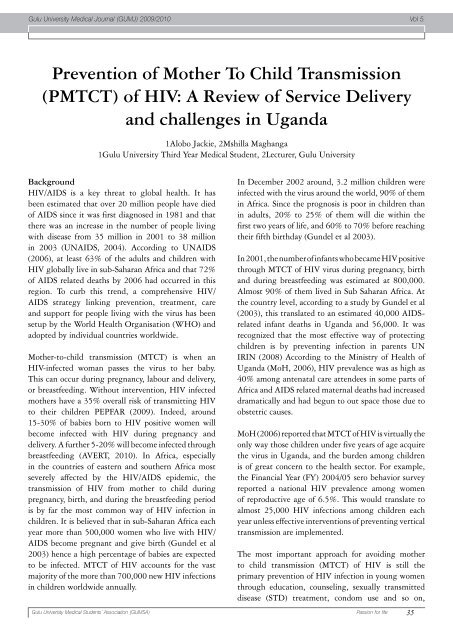GULU UNIVERSITY MEDICAL JOURNAL
GULU UNIVERSITY MEDICAL JOURNAL
GULU UNIVERSITY MEDICAL JOURNAL
Create successful ePaper yourself
Turn your PDF publications into a flip-book with our unique Google optimized e-Paper software.
Gulu University Medical Journal (GUMJ) 2009/2010 Vol 5.<br />
Prevention of Mother To Child Transmission<br />
(PMTCT) of HIV: A Review of Service Delivery<br />
and challenges in Uganda<br />
1Alobo Jackie, 2Mshilla Maghanga<br />
1Gulu University Third Year Medical Student, 2Lecturer, Gulu University<br />
Background<br />
HIV/AIDS is a key threat to global health. It has<br />
been estimated that over 20 million people have died<br />
of AIDS since it was first diagnosed in 1981 and that<br />
there was an increase in the number of people living<br />
with disease from 35 million in 2001 to 38 million<br />
in 2003 (UNAIDS, 2004). According to UNAIDS<br />
(2006), at least 63% of the adults and children with<br />
HIV globally live in sub-Saharan Africa and that 72%<br />
of AIDS related deaths by 2006 had occurred in this<br />
region. To curb this trend, a comprehensive HIV/<br />
AIDS strategy linking prevention, treatment, care<br />
and support for people living with the virus has been<br />
setup by the World Health Organisation (WHO) and<br />
adopted by individual countries worldwide.<br />
Mother-to-child transmission (MTCT) is when an<br />
HIV-infected woman passes the virus to her baby.<br />
This can occur during pregnancy, labour and delivery,<br />
or breastfeeding. Without intervention, HIV infected<br />
mothers have a 35% overall risk of transmitting HIV<br />
to their children PEPFAR (2009). Indeed, around<br />
15-30% of babies born to HIV positive women will<br />
become infected with HIV during pregnancy and<br />
delivery. A further 5-20% will become infected through<br />
breastfeeding (AVERT, 2010). In Africa, especially<br />
in the countries of eastern and southern Africa most<br />
severely affected by the HIV/AIDS epidemic, the<br />
transmission of HIV from mother to child during<br />
pregnancy, birth, and during the breastfeeding period<br />
is by far the most common way of HIV infection in<br />
children. It is believed that in sub-Saharan Africa each<br />
year more than 500,000 women who live with HIV/<br />
AIDS become pregnant and give birth (Gundel et al<br />
2003) hence a high percentage of babies are expected<br />
to be infected. MTCT of HIV accounts for the vast<br />
majority of the more than 700,000 new HIV infections<br />
in children worldwide annually.<br />
In December 2002 around, 3.2 million children were<br />
infected with the virus around the world, 90% of them<br />
in Africa. Since the prognosis is poor in children than<br />
in adults, 20% to 25% of them will die within the<br />
first two years of life, and 60% to 70% before reaching<br />
their fifth birthday (Gundel et al 2003).<br />
In 2001, the number of infants who became HIV positive<br />
through MTCT of HIV virus during pregnancy, birth<br />
and during breastfeeding was estimated at 800,000.<br />
Almost 90% of them lived in Sub Saharan Africa. At<br />
the country level, according to a study by Gundel et al<br />
(2003), this translated to an estimated 40,000 AIDSrelated<br />
infant deaths in Uganda and 56,000. It was<br />
recognized that the most effective way of protecting<br />
children is by preventing infection in parents UN<br />
IRIN (2008) According to the Ministry of Health of<br />
Uganda (MoH, 2006), HIV prevalence was as high as<br />
40% among antenatal care attendees in some parts of<br />
Africa and AIDS related maternal deaths had increased<br />
dramatically and had begun to out space those due to<br />
obstetric causes.<br />
MoH (2006) reported that MTCT of HIV is virtually the<br />
only way those children under five years of age acquire<br />
the virus in Uganda, and the burden among children<br />
is of great concern to the health sector. For example,<br />
the Financial Year (FY) 2004/05 sero behavior survey<br />
reported a national HIV prevalence among women<br />
of reproductive age of 6.5%. This would translate to<br />
almost 25,000 HIV infections among children each<br />
year unless effective interventions of preventing vertical<br />
transmission are implemented.<br />
The most important approach for avoiding mother<br />
to child transmission (MTCT) of HIV is still the<br />
primary prevention of HIV infection in young women<br />
through education, counseling, sexually transmitted<br />
disease (STD) treatment, condom use and so on,<br />
Gulu University Medical Students’ Association (GUMSA) Passion for life 35


